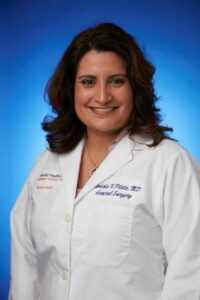
In the United States, one out of eight women will develop breast cancer at some point in her life.
The statistics are sobering. Breast cancer is the second leading cause of cancer death in women. Only lung cancer kills more women. The American Cancer Society estimates that about 43,700 U.S. women will die of breast cancer in 2023.
The good news is there has been a significant decline in breast cancer death rates: a steady decrease of 43 percent from 1989 to 2020.
Early detection and more targeted treatment options are reasons why breast cancer is killing fewer women, said Dr. Cynthia Plate, a breast oncology surgeon with the Maryland Oncology Hematology group.
Mammograms — an x-ray of the breast — are the best way to find breast cancer early, “when it is easier to treat and before it is big enough to feel or cause symptoms,” says Plate, who is affiliated with Adventist HealthCare White Oak Medical Center.
Breasts with dense tissue increase the risk that a cancer will be missed during a screening mammography. A regular ultrasound is recommended in addition to a mammogram, Plate says.
Screening guidelines encourage women to start getting mammograms at age 40 and have them done every year. For women who are at higher risk, “it is recommended that they start annual mammograms ten years prior to when their mother or sister was diagnosed,” Plate says.
Plate saw a surge of breast cancer related to the pandemic when women delayed mammograms for months. “Cancers were caught much later. It’s been an unfortunate causation of the pandemic.”
Plate recommends self-breast exams, especially for women who aren’t old enough to start regular mammograms.
“I’ve had so many patients who, for whatever reason, did the self-exam and felt something. I recommend going to your physician,” Plate says. “It may not be something to be concerned about, but you want to make sure there’s nothing there.”
Plate says that “some lifestyle changes may help reduce the risk of developing breast cancer, but other risk factors are unavoidable.”
Age is a big risk factor. Women over the age of 50 are more likely to be diagnosed. In fact, the median age at the time of breast cancer diagnosis is 62.
Genetics play a role in breast cancer, Plate says. Mutations in the BRCA genes can lead to the development of breast and ovarian cancer. Genetic counseling can help individuals understand their risk, explore testing options and make informed decisions about their healthcare.
Some breast cancers grow in response to hormones like estrogen, Plate says. Factors are having a first pregnancy after 30 years of age or having no pregnancy. Early menstrual periods or late menopause can increase risk as well.
“Hormone replacement therapy affects cancer risk, but there are different ways of giving replacement therapy during menopause that don’t increase your risk,” she says.
Losing weight can lower breast cancer risk, Plate says, because adipose tissue (fat cells) in the body can produce and secrete estrogen.
Alcohol consumption has been linked to breast cancer because alcohol can increase estrogen levels. Consuming about two drinks a day actually increases your risk by 30 to 40 percent, Plate says.
Smoking also increases the risk of breast cancer, Plate says. Cigarette smoke contains toxins, including cancer-causing chemicals. Women who smoke or used to smoke are more likely to get breast cancer than those who don’t or never did. Smoking also raises your chances of dying of breast cancer after your diagnosis. And it makes the cancer more likely to come back.
“These are all lifestyle risks you can change in order to decrease your risk of breast cancer,” Plate says.
More information on breast cancer can be found at www.cdc.gov/cancer/breast/




